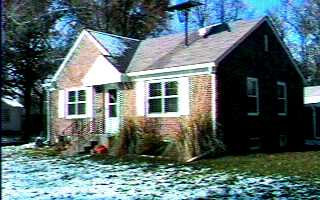
Sun Provides Electricity For Lincoln Home Of Greg and Linda Nelson
Look at the pretty pictures now, or view them in context :
What would you think if I told you that sunshine could be used in your home to power lights, television, and other household appliances? This fact in itself may not be too surprising, with today's technology, but for this form of energy generation to pay for itself in the near future, could be a revolutionary idea.
About six months ago, my wife, Linda, and I received two 40-watt solar panels, called photovoltaic panels or energizers, from a Maryland [ Solarex ] manufacturer. The fascination of using solar energy to power a small electric motor for a ninth grade science project helped me to develop an interest in outer space and energy conservation.
The photo-electric effect, upon which the PV technology is based, means simply that small amounts of direct current electricity are created when light shines on thin layers of unlike minerals such as silicon and cadmium sulfide. A minute energy unit, called a photon, falls through the layers of minerals, releasing an electron with a negative electrical charge. Millions of electrons are collected on the back of solar cells and the electrical charges are combined until a useful power is produced. The PV units used in our home produce 40 watts each at 12 volts DC, providing the sunlight is strong.
With the use of one or more 12-volt deep-cycle batteries, electrical systems can operate at night or during cloudy weather. The system in use will now provide electricity for a small color television, several fluorescent and incandescent lights, and a fan in summer. By being careful not to waste electricity, a four-to five day supply can be generated and stored between sunny days. This depends, of course, on how much electricity is used.
During the winter we can generate about 320 watts per day, and during the summer about 450 watts. These figures are for clear sunny days. During the winter months, solar-generated electricity accounts for only a small amount of the total power consumed. However during the summer months, we hope the PV's will produce up to half of our electrical needs - except for heavy appliances, such as central air conditioning, electrical stove and refrigerator.
During our first half year of sun produced electricity (from July 8 to December 31 1983) an estimated 10.4 kilowatts-hours of electricity was produced by our two PV's. For an entire year, an estimated 131.4 kw-hrs of electricity could be produced, based on an average of 4.5 hours of sunshine.
Less electricity can be generated in winter, due to shortened hours of daylight, and longer periods of cloudy weather. During the first 176 days of operation, an estimated 16.4% of the sun's energy potential at the ground was put to effective use. A loss of 10-20% may be experienced through house wiring, battery discharge, and "reverse leakage" into the PV's at night. Nevertheless, the first half-year of operation went better than expected.
As to the cost, about $1,615 was spent in 1983 for the system, including the PV panels, 12-volt fluorescent and incandescent lamps and fixtures, an oscillating fan, extension cords, and plugs, a deep cycle battery and cables, battery charger/load management/switch/fuse units, fuse box and fuses, PV books and catalogs, plywood, correspondence, and miscellaneous.
Source : Alliance Times-Herald, 31 December 1983. Thanks to Hugh Bunnell for his support.
Go to Top
and Digital Metering and Alarm System (DMAS) (photo). Try this link to Speciality Concepts. The SCI charger came online September 1983 and the DMAS arrived in January 1984.
Photos scanned from the original newspaper article : Inside Connections Clear View of Sky TV running on Sunshine - no wires! PV bits & pieces
Click on any pretty picture to make it bigger, then Back to continue reading.
More photos and further description of our home PV system will appear here
Go to Top
Products and Companies used in this home installation Here's a more complete list of our PV stuff
Go to Top
Reference materials
Davidson, Joel and Komp, Richard The Solar Electric Home : a photovoltaics how-to handbook, published
by aatec publications, Ann Arbor MI. (c) 1983 Maycock, Paul D. and Stirewalt, Edward N. Photovoltaics : Sunlight to Electricity in One Step, published by
Brick House Publishing Company, Andover MA. (c) 1981. Richter, H. P. Wiring Simplied, published by Park Publishing Co., Minneapolis MN, 18th Edition. (c) 1946.
Williams, Anna Fay The Handbook of Photovoltaic Applications : Building Applications and System Design
Considerations, published by The Fairmont Press, Inc. Atlanta GA 30324 (c) 1986. Williams, J. Richard. Solar Energy : Technology and Applications, published by Ann Arbor Science
Publishers, Inc., Ann Arbor MI, Second Printing, 1975. (c) 1974.
Go to Top
Some interesting organizations This does not imply an endorsement for a product, company or organization
Please email me updated links or suggest new ones. Thank you.
"Today, Nebraska is the only state in America that is totally served by public power and it is paying dividends. Nebraska residents have reliable electricity with some of the lowest rates in the nation. In addition, control of this public asset is maintained at the local level. Local people, making decisions on behalf of their neighbors. That's what public power is about in Nebraska" (from their website).
Go to Top
Return to Greg's Home Page To some PV Notes Making this document (09 Oct 02)